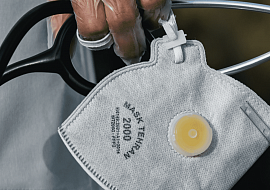Evaluate the state of the equipment, the date it was acquired, the degree of its efficiency, operating costs and existing automation processes on the Enterprise. This will help you understand in what aspects the manufacturing process should be improved.
How to avoid risks before implementing Industrial IoT solutions?
“127 devices hooked up to the Internet for the first time every second in 2021, and in North America alone the worth of Smart factories is expected to reach $500 billion in 2022.”
This trend is not surprising, as EIoT implementation helps to achieve a level of worker safety that was unattainable before, as well as new business models, and, therefore, new revenue flows. Using IoT devices, you will be able to get more information about manufacturing processes, employee and client behavior, and data that will help predict breakdowns and prevent downtime of equipment. Sounds tempting? All these benefits are achievable, but they depend on the company's ability to correctly assess the risks of EIoT implementation.
There are some risks to be considered when assessing the implementation of an IoT ecosystem, like potential hardware malfunctions or economic costs. However, almost all of these risks can be mitigated with a transparent business strategy, goal setting, and an accurate cost-benefit analysis of implementing Industrial IoT. It is not cheap to transform an ordinary factory into a Smart one, but it will be much better for your business to avoid common mistakes from the very beginning, rather than needing to correct them after implementation. Here we consider the most common risks to avoid while implementing the IoT ecosystem.

Unmet business expectations after implementing Industrial IoT Solutions
According to a Cisco report, a couple of years ago only 26% of companies considered their IoT initiatives to be successful. It means that their expectations have not been met, or the costs of technologies did not pay off. The complexity of an EIoT project is also often underestimated, which leads to postponement of implementation at the POC stage. As a result of that, the business is likely to suffer.
How to avoid unnecessary costs?
It is critical here to understand that the transition to the IoT ecosystem is a complicated process that will affect business models, employees, and the architecture of the Enterprise. Therefore, it is important to entrust qualified managers to assist in creating a plan and working on the IIoT implementation. Managers will help to define the desired results before the beginning of the project, as well as to employ a qualified team of engineers and optional experts such as data scientists, computer scientists, or statisticians for the IoT implementation.
EIoT initiatives should always solve specific business issues, which have to be determined before the execution of Enteprise IoT Solutions. When planning the implementation of IoT at an Enterprise, we advise you to focus on:
- improving quality of the product
- increasing equipment utilization
- accelerating production cycles
- increasing safety and security levels of the overall Enterprise
Identify priority areas, current challenges, and goals to reach in the future. Be sure to define the KPIs you are planning to attain. The company's business goals should be realistic and attainable, to make sure your expectations would match the actual results of implementing the desired solution.
Although the implementation of the IoT ecosystem has to minimize human participation, people will still have to master new working conditions. Therefore, the next crucial point is to discuss all changes that might happen to the Enterprise, assign roles between employees and machines, and train the team to work in a new business and technological model.
Compatibility and programming issues
Industrial IoT solutions are often implemented at Enterprises with a high proportion of machine manufacturing. For a well-funded company, it is often easier to implement the IoT ecosystem using modern equipment. But for some, it would be too expensive to replace legacy manufacturing systems. Therefore, companies often choose to adapt existing equipment and enhance it with sensors, smart devices, and gateways. However, when choosing to implement IoT technology in an Enterprise equipped with old machines, the company has to ensure protocols are understandable for all the devices to connect disparate data stores, and solve all the compatibility issues. According to McKinsey, a company moving to EIoT has to solve compatibility issues for about 50% of all devices. If compatibility issues are not solved appropriately, the solution may not function as intended, or even at all.
The wrong algorithm or incorrect integration can lead to hardware malfunctions and equipment damages, overheating, explosion, or system failure. These issues can cause other problems for companies such as disruption of the production process, reputation risks, lawsuits, and, in the worst case, work-related injuries. The problem of incorrect programming or lack of compatibility concerns not only the IoT ecosystem, but also other interconnected devices.
How to deal with device incompatibility issues?
As in the case of business expectations, it would be better to create a detailed analytical plan of EIoT implementation to minimize the risks of incompatibility and incorrect programming of the solution. Since any electromechanical device can become a part of the EIoT ecosystem, you have to evaluate whether it is more financially beneficial to integrate existing equipment into the IoT system, or upgrade with new replacements. A solution for equipment should also be selected based on specific details. You should consider information about the following in your implementation plan:

.svg)
How your business collects and processes data, and how you would ideally like it to be. Decide if it would be more efficient to develop a new solution, or implement the existing one.

Choose the best development partners and suppliers. They can help you create software products that will enable a secure and interoperable IoT ecosystem in their specific environment.
Need help implementing Industrial IoT Solutions?
Remember that various hardware malfunctions can happen not only on the Enterprise that has implemented the Enterprise IoT solutions, but elsewhere as well. So, you should pay a bit more attention to the quality of the Industrial IoT solutions that can be implemented from external partners, and don’t experiment with non-reliable ones. Qualified EIoT managers can help to pick out the most suitable solutions for the Enterprise.
Practical issues to consider when implementing Industrial IoT solutions
Implementation of the IoT ecosystem might require additional machines, devices, controllers, transmitters, and computers. So, you will have to manage more units of equipment after EIoT implementation.
To avoid problems with servicing new devices, we advise you to hire technical personnel who are experienced in working with IoT devices. Existing staff should also be specifically trained to work with the new equipment. This strategy will minimize problems with the maintenance of IoT devices, as well as controlling the existing equipment.
Data security risks to consider when implementing Industrial IoT solutions
The risk of data loss is one of the main reasons, along with cost, for companies to postpone transition to an IoT ecosystem. This is natural, because simply installing a VPN is not enough for IIoT protection. In theory, by gaining access to one device in the EIoT network, an intruder can disable the functionality of the whole Enterprise. For instance, an unhappy former employee might reprogram devices or steal confidential data. Therefore, security should be considered at every IoT level, from the individual device to edge computing and the cloud. To be sure of the reliability of the whole system, make sure that all the Industrial IoT solutions meet the highest safety standards. It would be better to contact EIoT security specialists for an assessment.
Unfortunately, the developers of Enterprise IoT solutions do not always make safety standards accessible. So, you have to conduct a security risk assessment. When choosing a solution, consider the level of security of these access points:
-
Sensors and actuators that can be hacked on site
-
Communication systems enabling data exchange
-
Computer storage platform
-
The computer software that interprets the data
So, what can you do to prevent attackers from gaining access to your devices? First, we advise establishing secure connections to cloud services and secure remote access to on-premises resources, as well as encrypting the data. For the most confidential data, you can minimize the risks by using a local network. The internal network ensures that people from outside of the company do not gain access to the data. Don’t forget to provide modern IIoT devices and systems with unique identities and credentials, and apply authentication and access control mechanisms. Physical security measures may also be required to ensure that only authorized employees have access to IoT-equipped machines and the software used to program them.
In addition, in order to not lose data, the company should provide the IoT ecosystem with a standby standby source of power, such as uninterruptible power supply, built-in batteries, and solar panels. Moreover, in the case of network loss, the devices will stop transmitting data, and the whole manufacturing process will stop to.
Risk of losing control: can humans be replaced by AI with Industrial IoT solutions?
The wide adoptance of AI is likely to lead to the loss of human control when it comes to the manufacturing process. By implementing Industrial IoT solutions based on AI, you should establish boundaries of responsibility for human and artificial intelligence.
Technologies that can be used in Enterprise IoT solutions, such as machine learning, deep learning, computer vision, natural language processing, and Big Data analytics are all based on artificial intelligence. The problem of losing control is becoming more urgent as people entrust AI to make more complex decisions. So, the question arises: which important management tasks can be trusted to AI without harming the decision-making process in the company?
Regarding business strategy creation and building Enterprise architecture, the interaction of a person with a machine is more efficient than the interaction of machines with each other.This is because machines are flawless when working with complete data on regular operations, but a human can make responsible decisions in unusual, critical situations. Also, in case of the need for creativity, only people can provide the solution with the help of high-quality ideas. So, while considering the AI borders of functionality in your future IoT Enterprise, you should estimate:
- how mechanistic are the operations in your manufacturing process
- what new operations do you want to add to the manufacturing after EIoT implementation
- if the delivered IoT system will be capable of self-learning
In this regard, another question arises: what are the chances for machines to replace humans at all? This is unlikely to happen in the near future. Can a critical error cause a person to completely lose control of the manufacturing process? It can happen, and the consequences of this are hard to predict. So, to keep ultimate human control as well as make the business more productive, you should balance machine functionality approaches with human intelligence.
Conclusions about the implementation of Industrial IoT Solutions
At least in the near future, machines will not replace humans in manufacturing, although they will take on many functions. It doesn't matter if you want to transfer the entire factory to EIoT or to make the manufacturing process partially smart. In any case, you should approach IoT ecosystem implementation strategically:
- analyze the assets of the Enterprise to know their EIoT potential
- set business goals that can be reached through EIoT solutions,
- employ high-qualified staff to deploy the project,
- check the development partners and solutions before transferring to the IoT ecosystem
The investment in EIoT may not pay off instantly, but by managing the EIoT implementation process competently, you have every chance of reaping substantial benefits that were not available to the company before EIoT implementation.















